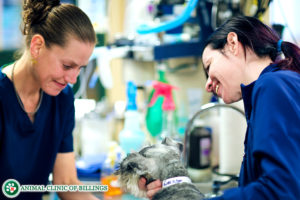external fixation surgery (KE) on dogs and cats
What is external fixation surgery?
External fixation surgery is a method of rigidly stabilizing a limb using surgical pins that are inserted through the skin, into each bone or bone fragment, and out through the skin on the other side. The ends of the pins protruding from the skin surface are then attached to a rigid external frame to hold them in the correct orientation.
What conditions can be treated with external fixation surgery?
External fixation surgery can be used to stabilize fractures, treat angular limb deformities, achieve limb lengthening, and to temporarily immobilize joints while repaired tendons and ligaments heal.
What are the advantages and disadvantages of external fixation surgery compared to internal fixation for fractures?
There are several advantages to external fixation over internal fixation. External fixation pins can be applied in a minimally invasive manner, with less disruption of the muscles and other tissues surrounding the bone. In the case of comminuted fractures, in which many small bone fragments are present and there is significant injury to the soft tissues surrounding the bone, external fixation allows for effective stabilization of the fracture site without causing further damage to the traumatized tissues, which can slow healing. Another advantage of external fixation is that the alignment of the bone fragments can be adjusted after surgery if necessary. Additionally, as the fracture heals, components of the apparatus can be removed in a stepwise manner to gradually decrease its strength, thereby subjecting the site to increasing forces which promote recovery. Finally, external fixation devices are much simpler and quicker to remove than internal implants.
Several disadvantages to external fixation must also be considered. Because the pins are inserted through tiny incisions in the skin, direct visualization of the bone is not possible, so optimal pin placement can be technically challenging, requiring detailed anatomical knowledge and precise understanding of the position of each bone fragment. Intra-operative x-rays are a very useful tool in confirming correct pin placement. Another disadvantage of external fixation is that the pins may disrupt the soft tissues they travel through between the skin surface and the bone, potentially interfering temporarily with normal muscle movement and causing irritation. It is also important to consider the risk of infection entering where the pins emerge from the skin; this risk can be minimized but not eliminated by regularly cleaning and dressing the pin tracts until the pins are removed.
What is the post-operative recovery with external fixation surgery?
The post-operative recovery period with external fixation is somewhat more demanding than with internal fixation. Following surgery, the pin sites are cleansed with an antiseptic solution and an antibiotic dressing is applied to each site. A padded bandage is then applied over the external framework for protection and patient comfort. The patient can usually go home 24-48 hours after surgery.
At home, the pin sites will need to be cleaned and dressed daily, and it is essential that the patient not be allowed access to environments in which their limb could get wet or dirty. It is typically recommended that patients only be permitted to go outside on a short leash to use the bathroom and go for short, controlled walks. It is important to prevent the patient from licking or chewing at the framework or the pin sites, as this could result in the development of a serious infection. The framework itself can cause damage if the patient bumps into things with it or gets things snagged on it. Confining the patient to a crate or small room can be helpful in limiting problems, at least initially until they get used to the device.
X-rays are taken every 4-6 weeks until bone healing is complete. After 6-8 weeks, the surgeon may choose to remove several pins and/or a portion of the external framework to expose the fracture site to minor forces that can promote further healing. Once the bone is fully healed, the rest of the apparatus is removed under sedation or brief anesthesia. The patient can then return to full activity over the following two to four weeks.
What are the possible risks and complications with external fixation surgery?
Potential complications with external fixation include infection of the pin sites and pin loosening. The risk of pin site infection can be minimized by careful adherence to a daily cleaning and dressing protocol, preventing access to contaminated environments, and keeping the patient from licking the areas. The risk of pin loosening can be reduced by carefully adhering to all activity restrictions.
What is the prognosis following external fixations surgery?
The prognosis for complete fracture healing and return to normal function with external fixation depends on the severity of the injury, as well as the patient’s age and health, and the quality of their post-operative care. In most cases, complete bone healing and a return to normal or near-normal function is achieved.

Let our highly trained and experienced team of veterinarians and veterinary technicians help you keep your cat as happy and healthy as they can be.
Call the Animal Clinic of Billings and Animal Surgery Clinic to schedule your pet cat’s next wellness examination with one of our veterinarians today!
406-252-9499 REQUEST AN APPOINTMENT
ANIMAL CLINIC OF BILLINGS AND ANIMAL SURGERY CLINIC
providing our region’s companion animals and their families what they need and deserve since 1981
1414 10th St. West, Billings MT 59102
406-252-9499



